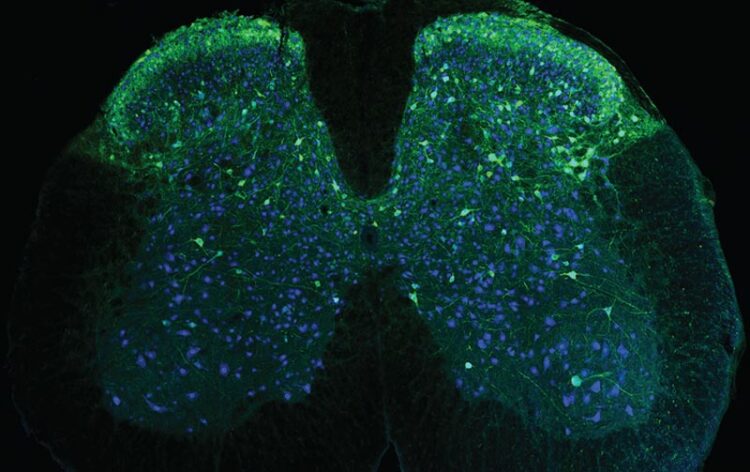Wearable microscopes advance spinal cord imaging in mice

Neurons in the spinal cord (blue), including those that send signals about pain (green), captured using one of the new wearable microscopes.
Credit: Salk Institute
Salk scientists invent wearable microscopes to produce high-definition, real-time images of mouse spinal cord activity across previously inaccessible regions.
The spinal cord acts as a messenger, carrying signals between the brain and body to regulate everything from breathing to movement. While the spinal cord is known to play an essential role in relaying pain signals, technology has limited scientists’ understanding of how this process occurs on a cellular level. Now, Salk scientists have created wearable microscopes to enable unprecedented insight into the signaling patterns that occur within the spinal cords of mice.
This technological advancement, detailed in two papers published in Nature Communications on March 21, 2023, and Nature Biotechnology on March 6, 2023, will help researchers better understand the neural basis of sensations and movement in healthy and disease contexts, such as chronic pain, itch, amyotrophic lateral sclerosis (ALS), or multiple sclerosis (MS).
“These new wearable microscopes allow us to see nerve activity related to sensations and movement in regions and at speeds inaccessible by other high-resolution technology,” says senior author Axel Nimmerjahn, associate professor and director of the Waitt Advanced Biophotonics Center. “Our wearable microscopes fundamentally change what is possible when studying the central nervous system.”
The wearable microscopes are approximately seven- and fourteen- millimeters wide (about the width of a little finger or the human spinal cord) and offer high-resolution, high-contrast, and multicolor imaging in real-time across previously inaccessible regions of the spinal cord. The new technology can be combined with a microprism implant, which is a small reflective glass element placed near the tissue regions of interest.
“The microprism increases the depth of imaging, so previously unreachable cells can be viewed for the first time. It also allows cells at various depths to be imaged simultaneously and with minimal tissue disturbance,” says Erin Carey, co-first author of one of the studies and researcher in Nimmerjahn’s lab.
Pavel Shekhtmeyster, a former postdoctoral fellow in Nimmerjahn’s lab and co-first author on both studies, agrees, “We’ve overcome field-of-view and depth barriers in the context of spinal cord research. Our wearable microscopes are light enough to be carried by mice and allow measurements previously thought impossible.”
With the novel microscopes, Nimmerjahn’s team began applying the technology to gather new information about the central nervous system. In particular, they wanted to image astrocytes, star-shaped non-neuronal glial cells, in the spinal cord because the team’s earlier work suggested the cells’ unexpected involvement in pain processing.
The team found that squeezing the tails of mice activated the astrocytes, sending coordinated signals across spinal cord segments. Prior to the invention of the new microscopes, it was impossible to know what astrocyte activity looked like—or what any cellular activity looked like across those spinal cord regions of moving animals.
“Being able to visualize when and where pain signals occur and what cells participate in this process allows us to test and design therapeutic interventions,” says Daniela Duarte, co-first author of one of the studies and researcher in Nimmerjahn’s lab. “These new microscopes could revolutionize the study of pain.”
Nimmerjahn’s team has already begun investigating how neuronal and non-neuronal activity in the spinal cord is altered in different pain conditions and how various treatments control abnormal cell activity.
Other authors include Alexander Ngo, Grace Gao, Nicholas A. Nelson, Jack A. Olmstead, and Charles L. Clark of Salk.
The work was supported by the National Institutes of Health (R01NS108034, U19NS112959, U19NS123719, U01NS103522, and F31NS120619), a National Institutes of Health Training Grant (T32/CMG), the Sol Goldman Charitable Trust, C. and L. Greenfield, a Rose Hills Foundation Graduate Fellowship, a Burt and Ethel Aginsky Research Scholar Award, a Kavli-Helinski Endowment Graduate Fellowship, and a Salk Innovation Grant.
About the Salk Institute for Biological Studies:
Every cure has a starting point. The Salk Institute embodies Jonas Salk’s mission to dare to make dreams into reality. Its internationally renowned and award-winning scientists explore the very foundations of life, seeking new understandings in neuroscience, genetics, immunology, plant biology, and more. The Institute is an independent nonprofit organization and architectural landmark: small by choice, intimate by nature and fearless in the face of any challenge. Be it cancer or Alzheimer’s, aging, or diabetes, Salk is where cures begin. Learn more at: salk.edu.
Journal: Nature Communications
DOI: 10.1038/s41467-023-36959-2
Article Title: Multiplex translaminar imaging in the spinal cord of behaving mice
Article Publication Date: 21-Mar-2023
Media Contact
Salk Communications
Salk Institute
press@salk.edu
Office: 858-453-4100
All latest news from the category: Medical Engineering
The development of medical equipment, products and technical procedures is characterized by high research and development costs in a variety of fields related to the study of human medicine.
innovations-report provides informative and stimulating reports and articles on topics ranging from imaging processes, cell and tissue techniques, optical techniques, implants, orthopedic aids, clinical and medical office equipment, dialysis systems and x-ray/radiation monitoring devices to endoscopy, ultrasound, surgical techniques, and dental materials.
Newest articles

First-of-its-kind study uses remote sensing to monitor plastic debris in rivers and lakes
Remote sensing creates a cost-effective solution to monitoring plastic pollution. A first-of-its-kind study from researchers at the University of Minnesota Twin Cities shows how remote sensing can help monitor and…

Laser-based artificial neuron mimics nerve cell functions at lightning speed
With a processing speed a billion times faster than nature, chip-based laser neuron could help advance AI tasks such as pattern recognition and sequence prediction. Researchers have developed a laser-based…

Optimising the processing of plastic waste
Just one look in the yellow bin reveals a colourful jumble of different types of plastic. However, the purer and more uniform plastic waste is, the easier it is to…



